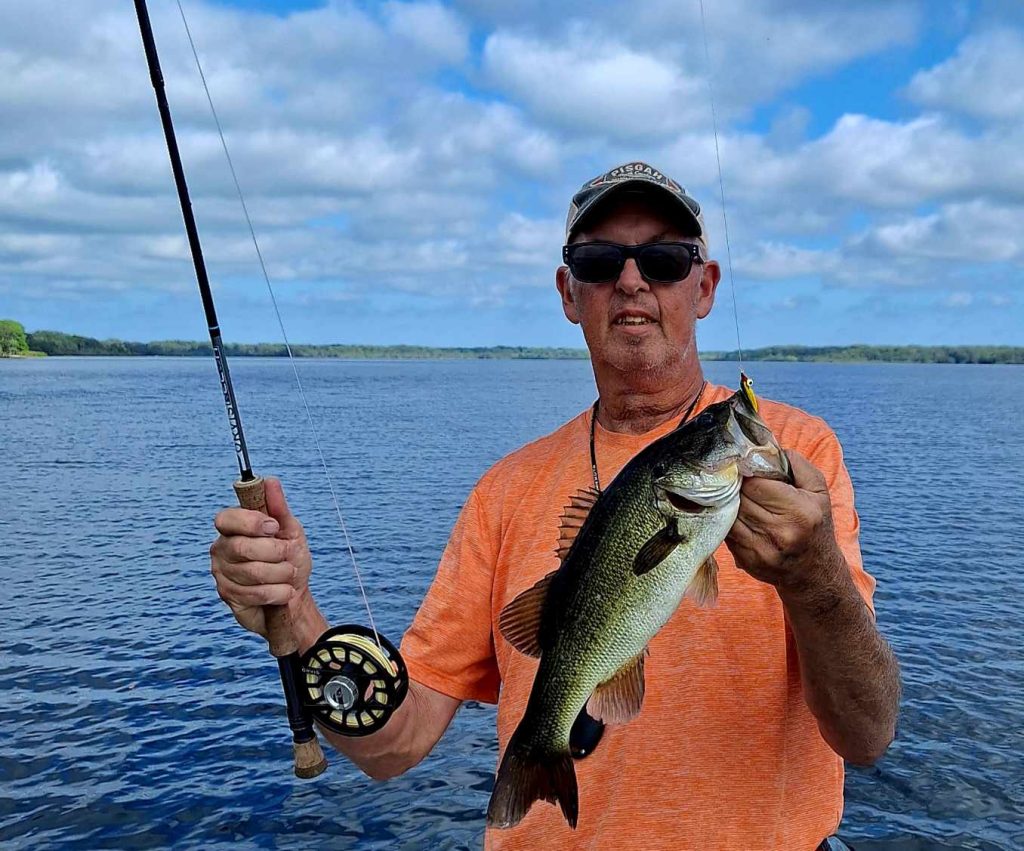Freshwater Fly Fishing in Florida
Anglers often overlook reshwater fly fishing in Florida. This is due to the saltwater fishing opportunities that are available. However, fly fishing for largemouth bass,bream and other panfish and other freshwater species is relaxing, productive, and just plain fun!
Click link to learn more about freshwater fly fishing charters in Florida
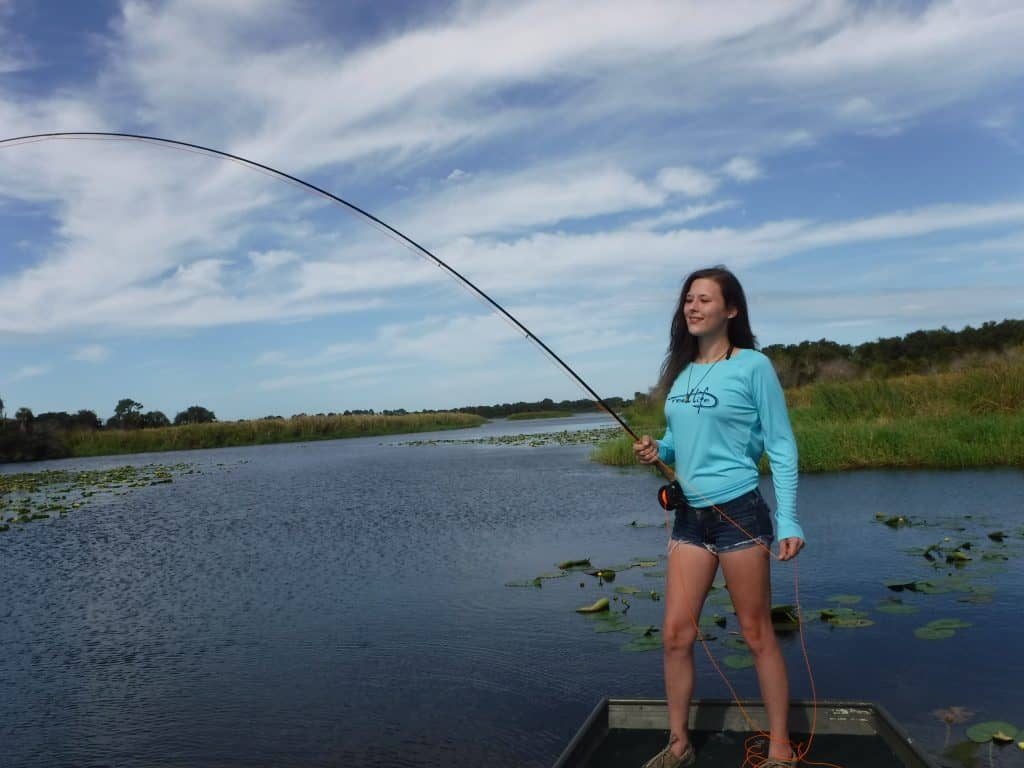
My name is Capt Jim Klopfer and I am a fishing guide based out of Inverness, Florida. I love fly fishing in freshwater! One of the main reasons that I enjoy this type of fly fishing is the ease and simplicity of it. Big boats, expensive tackle, and long casts are not required. Jon boats, canoes, and kayaks are the vessels of choice, and a modestly-priced outfit along with a handful of flies will get it done. Also, while I am a strong proponent of catch and release most of the time, anglers can actually improve some fisheries by taking some fish home for a meal. Catfish, tilapia, bass, bream, and other species will also take a well presented fly.
Freshwater fly tackle
My favorite outfit is a 4wt combo with a 6’ section of 6 lb leader. It is perfect for targeting panfish and small bass and will give anglers a fighting chance if a larger bass or catfish is hooked. A floating line is the best choice for most applications and is the easiest to both cast and manage. Anglers can go up in size if larger fish are being sought after. An 8wt rod is best when casting larger, wind resistant bass bugs and poppers.
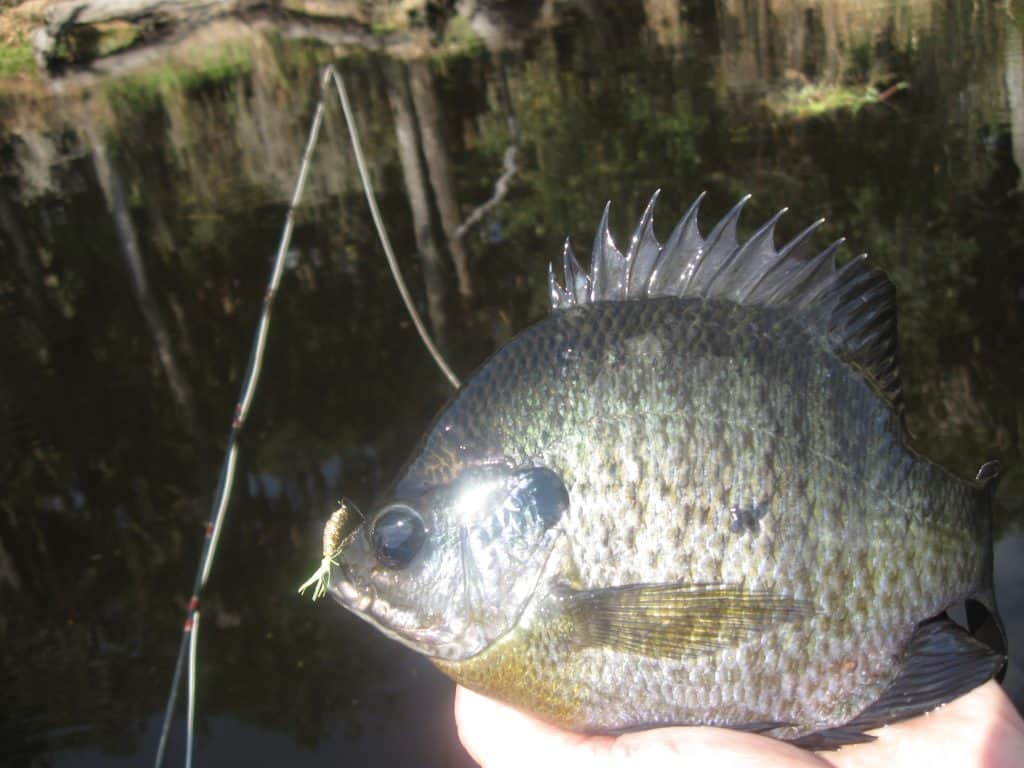
The reel can be inexpensive as the drag will rarely come into play. Fly selection is very basic; poppers and other floating bugs for surface fishing, minnow imitations for working the mid-depths, and sinking flies for crawling near the bottom. If I had to choose one fly to fish with it would be a #10 bead head black Wooly Bugger. That fly will catch virtually every freshwater species on the planet.
Best Florida freshwater fishing flies
Poppers are great fun to fish and are very productive, especially for bluegill and bass. Foam rubber bugs will also fool a lot of bream. Mornings and evenings and overcast days are usually the best times to use surface flies. While topwater strikes are great, plying the mid and lower depths will usually produce more fish.
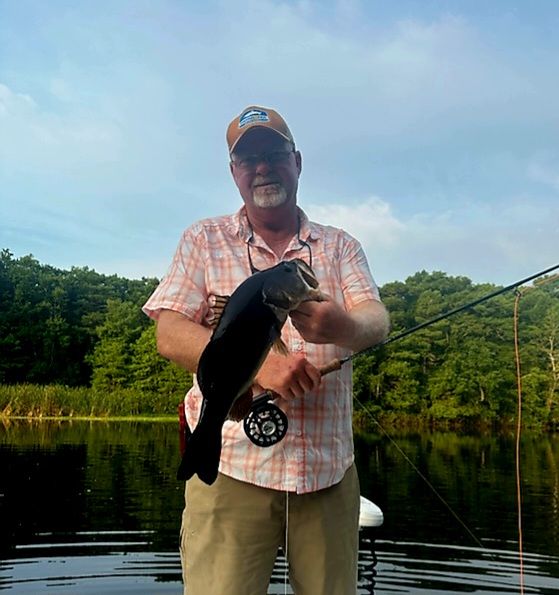
Bait fish patterns, knows as streamers, such as Lefty’s Deceiver and the Myakka Minnow with chartreuse in them have proven to be quite effective. Finally, anything dark and “buggy” such as a Wooly Bugger that will work the lower part of the water column will round out the flies needed to be successful. It is important to cover the entire water column.
Many of these flies are weighted to facilitate working the deeper water. These sub-surface flies are more productive for species of panfish other than the aggressive bluegill, such as crappie, stumpknockers, redears, shellcrackers, warmouth and catfish. Yes, catfish will take a fly! Often times the fish will take these submerged flies very subtly, making it difficult for a novice angler to detect the bite.
For this reason, “strike indicators” are often used. This is a piece of material (usually yarn or foam) that floats on the surface suspending the fly at the proper level. Stream trout fishermen have successfully employed this technique for decades. The “bobber” goes under; fish on!
Fly fishing for Florida bream
Fly fishing for bream is fun! It is a simple and basic form of angling that is both relaxing and productive. There are several species of small freshwater panfish that with take a fly. The best aspect of fly fishing for bream is that it is so relaxing. It is also a great way for anglers to hone their skills while catching fish. Bream put up an excellent battle on a light outfit!
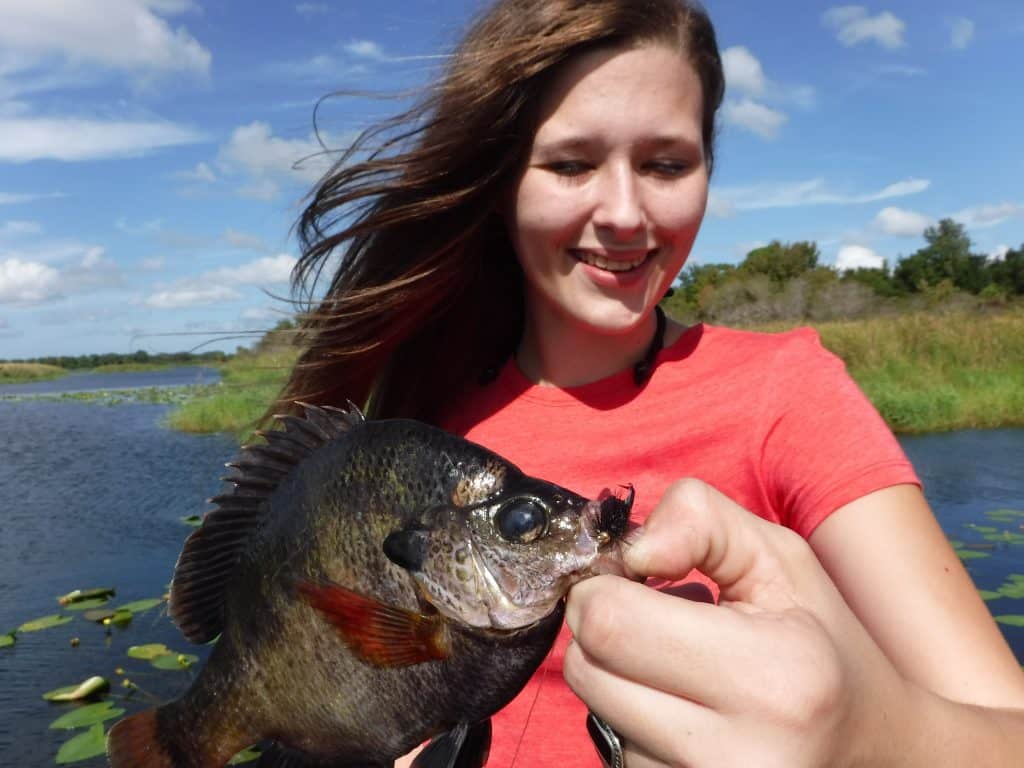
Crappie are known as “speckled perch” in Florida. Since these largest members of the panfish family primarily feed on minnows, small streamers will certainly fool these delicious fish. This is particularly true when the larger schools break up and the fish move to the banks. This usually occurs from mid October to early December, depending on weather and location.
Anglers fly fishing in Florida can find the current freshwater fishing regulations on the FWC website. They also have an excellent fish species identification chart to help anglers. There are many different panfish species as well as exotic species. Many of these fish are similar in appearance.
Techniques for catching Florida panfish on fly
As I stated earlier, one of the advantages of fishing for bream is the fact that long casts are not required. 20’ is plenty as most often the boat used is a canoe, kayak, or Jon boat with makes very little noise. Shore bound anglers can also do well. The fly is simply cast out towards a weed line, fallen tree, or some type of submerged structure or vegetation.
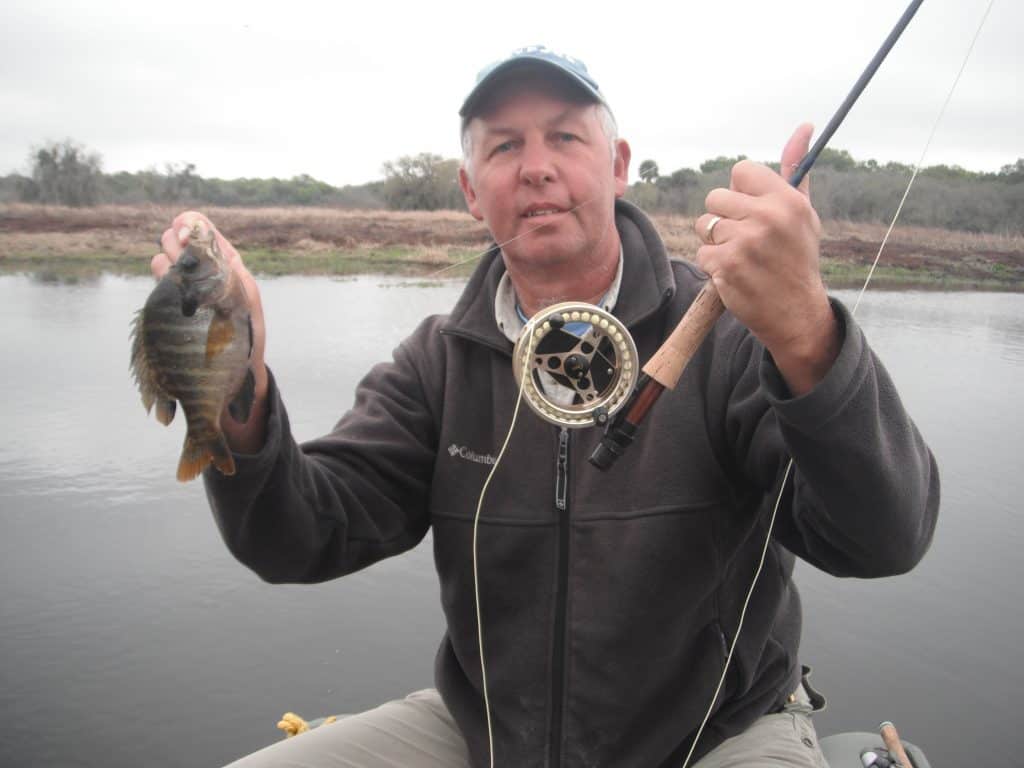
Poppers and surface flies are “twitched”, resulting in a commotion that will hopefully draw a strike. Don’t be in a hurry! Often times a bluegill will attack the offering as it lies motionless on the surface. Sub-surface flies are allowed to sink then slowly retrieved back using short strips with a pause in between.
As with all types of fishing, vary the retrieve and fly until a productive pattern emerges. Also, keep moving, covering as much water as possible until the fish are located. Freshwater panfish tend to congregate, once a productive area is located, work it hard until the action slows, then move on. The same approach will produce largemouth bass as well. In reality, while called “bass”, they are really the largest member of the “sunfish” family.
Fly fishing with the popper/dropper rig
Another very effective technique is the “popper/dropper” rig. The popper takes the place of the strike indicator and offers the fish an added opportunity to get caught. A popper is tied on to the line then an 18” to 24” piece of light (4-6 lb) monofilament leader is tied to the bent of the popper’s hook. A small nymph or other submerged fly is tied on the tag end and the rig is complete.
It is cast out, allowed to settle, and “popped” with a sharp twitch. The lower fly rises up then slowly and seductively descends towards the bottom. If the popper either gets eaten or disappears (which means a fish has grabbed the “dropper”) the rod tip is lifted and it is “fish on”! This is a great option as it covers the surface as well as the mid depth. Also, the take on a subsurface fly is often very subtle. The popper makes it much easier to detect a strike.
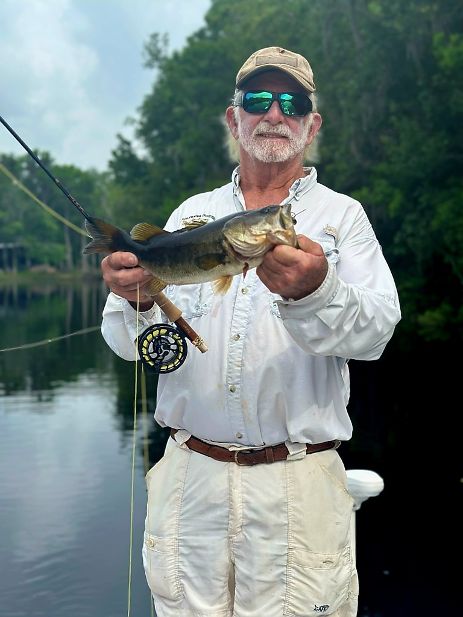
Fly fishing for largemouth bass in Florida
An added benefit that fly fishing in freshwater for panfish offers is that bass will inevitably be hooked while targeting bream.Laremouth bass are the top freshwater game fish in the United States. Florida is well known for it’s excellent largemouth bass fishing! Anglers have a choice when persuing bass; either go light for smaller fish or beef it up for larger fish. The techniques and flies that fool panfish will work well on smaller bass, with perhaps stepping the fly size up a bit.
Anglers fly fishing for bass will need heavier tackle for a couple of reasons. Bass like a big meal and larger flies and poppers will get their attention. These bulky, wind-resistant flies are much harder to cast. 8wt outfits with a floating line work best. Leaders should be short and simple. 3′ of 40 lb butt section followed by 3′ of 25′ tippet will be fine. Poppers work great on the surface. Large streamers such as Deceiver patters are best fished below the surface. Weed guards are often used to help reduce snagging on the weeds.
Weeds and submerged vegetation are top spots to search for a bass on fly. This type of fishing is best done in fairly shallow water. Bass are tough to catch on fly when they move into deeper water. The best areas will have some weeds and distict edges, but also plenty of open water in which to work the fly. Bass found schooling on the surface in open water are certainly good prospects.
Largemouth bass from 1/2 pound to 2 pounds are abundant in most Florida waters, over-abundant in some fisheries. In fact, the Florida Wildlife Commission (FWC) made a rule change in 2016 for largemouth bass. There is no minimum size and a limit of one fish over 16” with a bag limit of 5 fish per person. The goal is to harvest smaller fish while releasing the larger specimens. This approach of keeping smaller bass to eat would hopefully improve the overall quality of fishing and increase the number of larger bass.
Other freshwater fish species
Florida has a wide variety of freshwater fish that can be taken on a well-presented fly. In fact, any fish that will hit a jig or other lure can be caught on fly. These include channel catfish, striped bass and hybrids, Suwannee and spotted bass, pickerel, and gar. Most of these will be “accidental” catches, though some anglers actually focus on one of these species.
Fly fishing for “exotics” in Florida
The very southern portion of Florida offers fly anglers a unique experience; fishing for exotic species. The canals, creeks, and ponds on Florida from the Everglades south are full of exotic species. These are not native fish. They have been introduced into the waters and flourished. Oscars, cichlids, and tilapia are the most numerous and well-known species. They can be quite aggressive, particularly oscars and cichlids.
The same techniques used for bream in Florida will catch these exotic species down south. In most instances, kayaks and canoes are the best way to access these hidden waterways. In the Miami area, peacock bass are also an option.
Freshwater fly fishing in Florida rivers
Lakes and ponds get the most attention when it comes to freshwater fishing, but rivers can offer fantastic fishing as well. Rivers also have other attributes that make them a good choice when fly fishing. They normally get very little pressure. Also, rivers offer more protection on breezy days. The scenery can also be spectacular! Finally, fish in rivers are much easier to locate; there simply is not as much water to cover.
During low water periods, this is especially true. Fish will congregate in the deeper spots in the river. The outside bends tend to have holes carved out by the current and are usually reliable spots. The same flies and techniques that produce in lakes will work well in rivers. When the water is high, fish will look for sloughs and coves out of the current.
Snook fishing in Florida rivers
Don’t be surprised if a snook inhales your fly meant for a freshwater fish. Snook can tolerate absolute fresh water and will be found in many Florida rivers. Capt Jim offers clients a very unique fly fishing experience; drifting local rivers such as the Myakka River, Manatee River and Braden River for snook, largemouth bass, and other species. These trips are run using a 14′ Alumacraft boat and clients will enjoy some enjoyable fishing in a serene environment with great scenery.
In conclusion, hopefully this article on freshwater fly fishing in Florida will encourage anglers to give the long rod a try!
